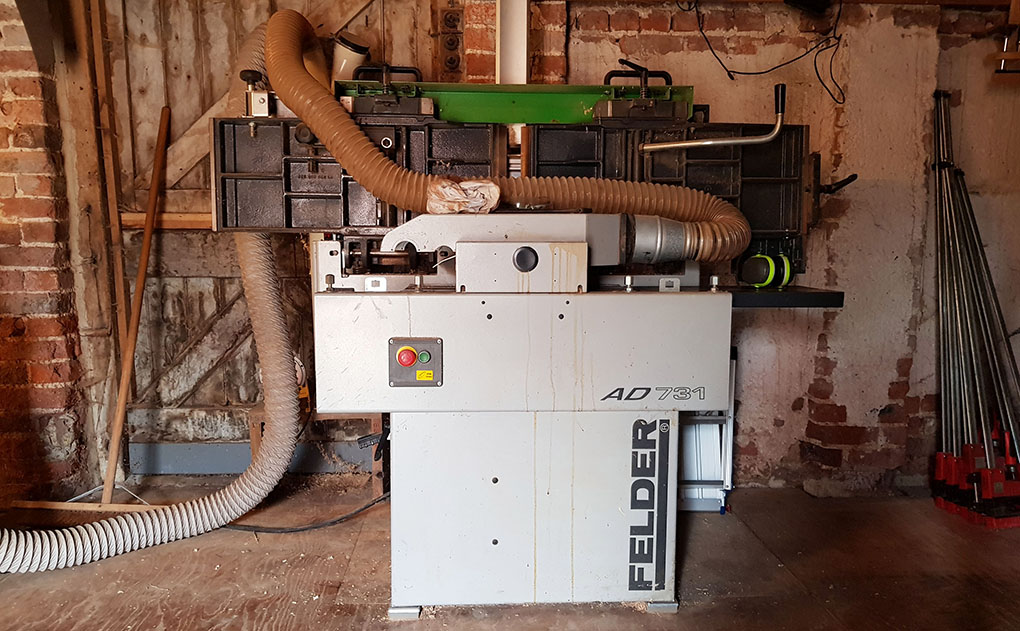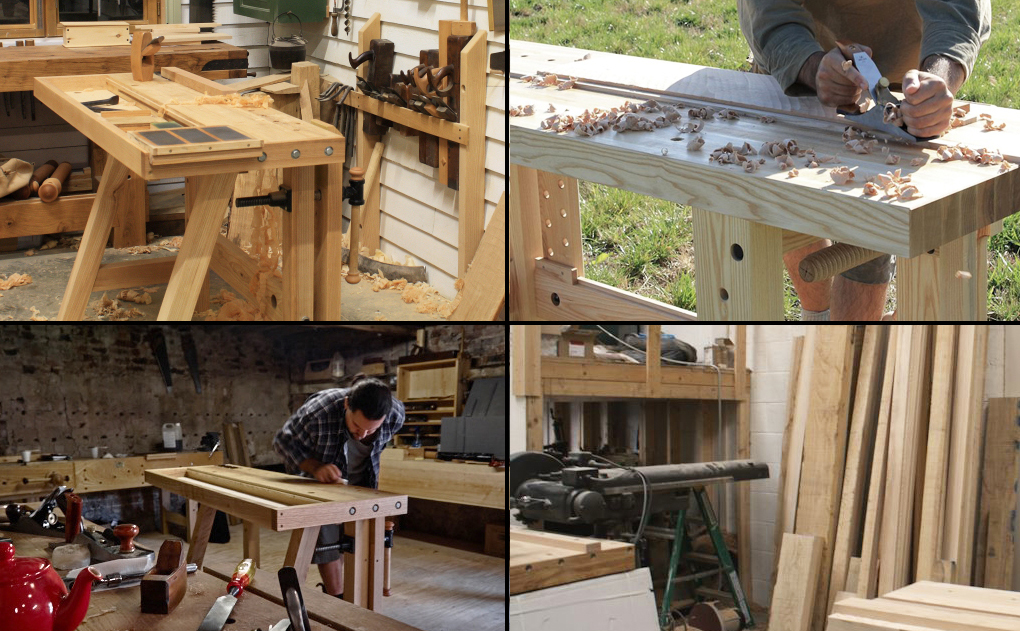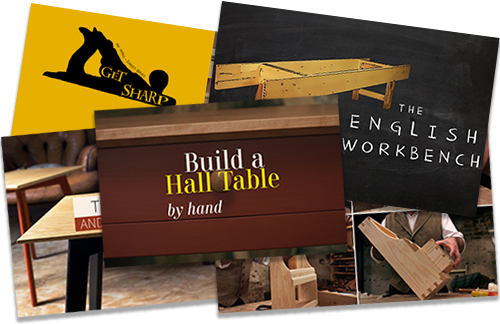For most of you time is not money when it comes to your workshop.
But I will always stand by my belief that it could be.
Small scale furniture making can be a profitable business, and as crazy as it sounds hand tools are the key. Single maker, small workshop, minimal tools. It’s perfect for low overheads.

There’s two important points that you’ll need to master though.
Firstly, you’ll need to be able to build efficiently.
And secondly, you’ll need to get good at identifying the pieces that will allow you to build efficiently.
Building for profit isn’t about showing off, you won’t be building to the best of your technical ability.
Instead you’ll be challenging your understanding of how to build most productively.
Most of us think we can do more in a day than is actually possible. I know I do.
And we assume it’ll be much quicker the next time around.
But in the hand tool workshop efficiency doesn’t come from years of practice, shaving off a second here and a second there. Or this three minute dovetail nonsense.
Of course we all get quicker for doing, but the real gains come from being clever rather than being repetitive.
By following the same technique for years your work will definitely speed up.
But by changing the technique itself you could become twice as fast almost immediately.

A jig can take minutes to make and save time when marking repeatedly.
An Efficient Approach Should Be Applied To All Areas Of Our Work
If you’re learning how to use a hand plane to flatten boards for example, then don’t aim to take shavings faster, just take less of them. You need to make every shaving count.
You could also invest a little time in making a jig, or using a story stick to save time on repeat tasks.
Or cut mortice and tenons that are gappy, because you know it won’t be seen (plus this gives other benefits).
Of all of the clever time savings, the most important is choosing the right piece to build.
From Concept To Production
When I’m weighing up a new project, I’ve already built it in my head three times before worrying what it looks like. This is a process that I go through instinctively, because I’m bred to make this into a living. I’ve got to think, how am I going to sell this? How will I make any money?

The initial chair design would take too long to build to be offered for anything close to a sensible sales price.
A good example was our concept chair design.
On building the first prototype I knew that chair would need to be sold for far more than would be reasonable to charge. Yet after a bit of a redesign I could easily have halved the price, and could probably turn them out one a day.
For the customer, there was no noticeable difference to the value, in fact I think the faster build makes for the more saleable chair visually.
This stuff is often missed when a student is learning.
It’s not uncommon for them to build an over the top masterpiece, but that doesn’t prove at all that they could make a living.
If I was judging a student’s work, it wouldn’t be the tightest joint that I’d look for, but whether they’d figured out how to make their time count.
Efficiencies at the design stage might start with materials.
Are you using more wood than necessary? Have you picked a section size that requires a half inch removing from the thickness, when you could just be skimming your boards up?
Then consider if any complex areas could be simplified.
Do you understand your woodworking well enough to maintain strength but build it in half the time?

The design was simplified to become a much more efficient build. That one’s a prototype – just a bunch of sticks screwed together, so you may need a bit of imagination.
With our chair one of the considerations I had was glue squeeze out.
We had an arm rest joined on top of the each chair side, and I knew cleaning up that dried glue would slow things right down.
I thought through a few options and came up with a work order that would give the best speed. Then in the end I scrapped the arm rests altogether.
I reoriented the members of the main frame to give the width I was after without needing a separate unit.
Naturally I’m always going to do the hard stuff when it gives me something in return, but I didn’t think these handrails were working hard enough for the extra morning’s work they’d take.
It’s been an odd feeling launching this Chair Build without an actual chair to show you.
Instead you got a chap in a messy workshop, a blocky sketch and the temptation of the word ‘commode’.
We are so grateful that so many of you took a punt with this right from the off. It’s been a huge drive for both of us.
I’m still feeling like one knackers hanging out when we publish images of a prototype, but I’m back in my comfort zone this week as I’m cracking on with the main build.
We keep this page updated as we add new content to the Series, so you can have a check and see where we’re up to.

![Simple Work Holding For Ploughing Grooves [Without a Tail Vice]](https://www.theenglishwoodworker.com/wp-content/uploads/2022/07/workholding-without-tail-vice-copy.jpg)



Perhaps you’ve already considered this, but making the front rail below the side rails, instead of above, will create a little waterfall effect making chairs more comfortable to sit in as the pressure point under the thigh is reduced.
Thanks Jeremy, that’s a very good point.
With this chair we did have a play, but in the end we went for such a low slung chair that the rail doesn’t seem to come in to contact with your leg – maybe if you were a child it would.
We used the staggered joinery to create an almost slobbing type seat lean in a really basic way – part of our rules was square joinery.
If the chair was any taller I think we’d definitely have to adopt lowering that front.
Cheers.
It really is interesting to follow through the process – there’s a huge amount to be gleaned. But like you say – it must feel like you’re really hanging it out there, so thanks for taking the chance and going for it.
And I can’t help be curious whether knacker makes international translation 🙂
Great article..I try to scrape a living woodworking and this is stuff I know, but need constant reminding.. Hard to get that balance between the satisfaction of doing good work and the financial gain of efficient work.
Loving your content Richard. I am English but live abroad so enjoy the Brit character coming through and I like your approach.
@Russ.. exactly my thought s re: “one knacker hanging out”.. considered posting an explanation for those outside the UK who surely won’t have got that.. (Knacker=Testicle)…
Richard, I’m not a professional woodworker (it’s only a hobby to me), but your perspective is useful for me as well. There’s only 24 hours in a day and we all need to prioritize our activities and choose what we will accomplish in a given day.
Jeth, thanks for clarifying that. I’m not English and I do hear lots of bollocks on TV, but knackers was a first to me.
Cheers,
LOL. Very true this has got me thinking more about design .
To be knackered in French is Creve but the final e is an e acute pronounced Crevaiy
Having recently retired?? After 63 years of designing and making furniture Richard I can tell you it never gets any easier. but, I would not change a minute of it. I seem to have made enough to live on. Well, I do not have any debts. Financial ones at least but, I will never, ever. be able to re-pay all the love, hard work and kicks up the Arse I have received from my wonderful wife Sue.
Hi Peter,
I can very much relate to that. If it wasn’t for Helen I think I’d have broken years ago!
I want to add to this topic soon about selling, but the internet has for myself made it a lot easier and I think it can be a great tool for small makers.
It’s always lovely to hear from someone who’s made it to retirement building furniture, I hope one day I can say the same!
All the best.
M.C. Escheresque sketch of the chair has the chair back joining the back rail on the left side facing the chair and it joins the side rail on the right side. I’ll show it to my wife so she can see why it takes me so long to finish anything.
Richard, I’ve enjoyed your blog for years and I commend you for pulling back the curtain, so to speak. We live in a golden renaissance of woodworking yet so much writing is devoted to the first steps we all have to take as woodworkers. I commend you for letting it all hang out and sharing the path that lays beyond the first workbench build or home made mallet. There is no one road ahead for each of us, yet the rules of the road are same for us all. Thank you for giving us a fuller picture of woodworking beyond the first act.
Some very good points. A different aporoach, a new way design. Thanks
Hi Richard
I’m liking this approach with the chair build , at first I wasn’t quite sure but after watching the first few I’m hooked I’m like a sponge soaking up all the ideas .
A know how you must of been feeling doing this like you say with one hanging out 😂
But I think you can safely tuck (jimmy and the twins) back in !
And crack on with the build !
This post is great as well , as I’m looking at how to be able to make a living from making furniture,nothing to complicated like you say,well also I don’t have the skill set as yet .
But I’m hoping by watching your videos that’s gonna change ,I’m half way there as I’ve been a carpenter since I left school but I’m 40 now
Self employed with a bad back , and as much as building roofs , hanging doors , joist etc is ok and pays the bills it just doesn’t have the excitement as watching your videos and seeing what you can build and not a piece of sodding MDF in sight amazing!
A think once I get the bench built then I be able to get more practice.but until then and after all my rambling, I’m going to enjoy these videos that you and Helen make there absolutely brilliant can’t wait for the next one !👍
Ha ha, cheers!
All the best with your change of direction, really hope that works for you (make it work out for you).
If you can hang doors you’ve got nothing to worry about. I think confidence is the biggest stummbling block for people starting out woodworking, the truth is we can all do it, it’s an art form of process and once you know the process, job’s a good’un.
I’ll do some more posts, maybe some videos on starting out, I feel a lot of people could be interested.
Thanks for the reply Richard a know you must be busy , that’s good advice there’s one thing I can definitely say that will boost anyone’s confidence in woodworking and that’s the get sharp videos I chose to do it the Maguire way 👍
Diamond stone, oil stone, and strop
I can honestly say I’ve never had my chisels and plane irons so sharp unbelievable, a think if you hadn’t of done them videos I would of got frustrated an give up hand tool wood working just for the simple fact that me bloody tools would of been blunt even though I would of thought they were sharp and that’s how hand working would be so thanks for that .
I definitely think some post or videos on how to get started on trying to make a living from this work would be great keep up the good work cheers
I really appreciate that, thank you, it means a lot.
What people don’t realise is I’m actually a crap woodworker… just with sharp tools 😉
Sorry for bouncing into your comment Steven.
Richard, I can’t wait to be a crap woodworker like you! Sharp tools-n-all.
Ivan.
I like the way you think, Richard. There is passion, but there is also a sense of reality and purpose.
Good job and move on.
Between You and Schwarz the light bulb has come on. I need to get on with it. Quit waiting to get some other neat tool to build something.
I have saws, chisels, planes, and other tools. I have a workbench with a vise, dog holes, and sturdy (a solid core door top) base. I don’t need anything else. Just do it!!! Thanks for the inspiration.
I went from no tools and no where to work , to having a garage and a bench. I the. Filled the garage with all the tools the books , magazines and YouTube sites said I must have. Result: No room to work. I then saw Richards set up and the bulb came on. In the days when everything was done by hand; carpenters had to carry their tools on foot. They boiled it down to the bare minimum and improvised. The cost was also a factor. As late as the 1950s a British craftsman would pay a weeks wages for a quality tool.
So , I sold most of my kit and spent the money on quality essentials. This gave me the space I needed and a few edges to keep sharp. Now I make things rather than hoard stuff.
Nice comment Neil.
It’s becoming a common tale.
I am beginning to have a real appreciation for Richard’s thinking and procedures.
Ivan.